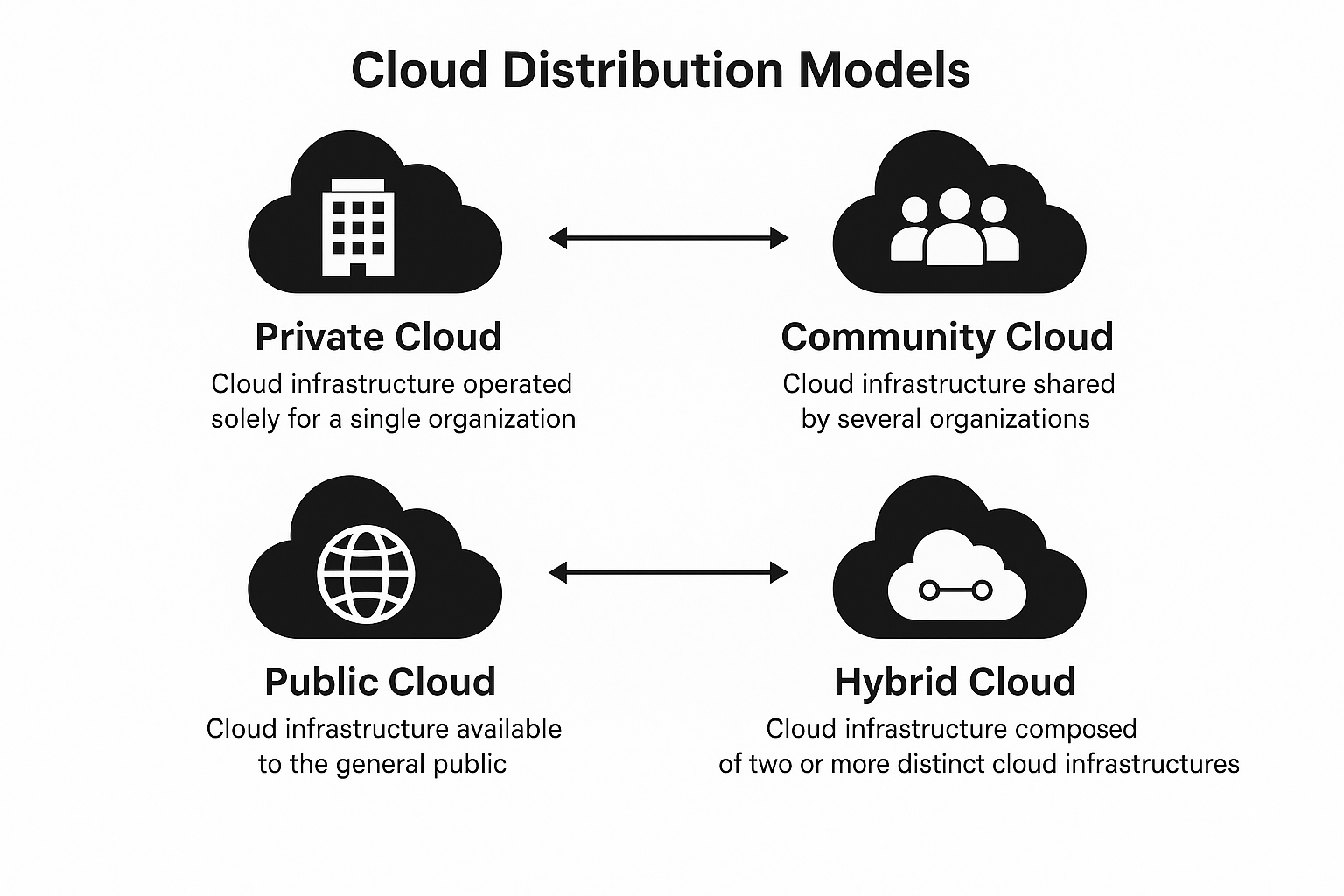Cloud distribution models—private, public, community, and hybrid—define how cloud infrastructures are deployed and governed. Beyond service models, these classifications are crucial for compliance, security, and organizational strategy. Learn how NIST definitions shape adoption paths and why hybrid solutions dominate modern ecosystems.
Table of Contents
Cloud Distribution Models
Beyond the service model of a cloud resource, understanding the cloud distribution model is crucial, as it plays a key role in the application of industry-specific regulations and national or continental security policies.
The NIST 800-105 (16) document provides definitions for the different cloud service distribution models.
Private Cloud
A cloud infrastructure that is exclusively used by a single organization composed of multiple consumers across various operational locations or branches. It may be owned, operated, and managed by the organization itself, a third party, or a combination of both. The infrastructure can exist either on-premises or off-premises.
Community Cloud
A cloud infrastructure that is exclusively used by a specific community of consumers from distinct organizations that share common interests and service objectives (e.g., operational missions, security requirements, policies, or compliance regulations). Ownership, operation, and management can be carried out by one or more organizations within the community, a third party, or a combination of both. The infrastructure may be located on or off the premises of the participating organizations.
Public Cloud
A cloud infrastructure that is made available for open use by any individual or business consumer. Ownership, operation, and management may be carried out by a commercial, academic, or governmental organization, or a combination thereof. This infrastructure is located at the cloud provider’s premises.
Hybrid Cloud
A cloud infrastructure that combines two or more distinct cloud infrastructures (private, community, or public), which remain unique entities but are connected through standardized or proprietary technology that enables data and application portability. Examples include load balancing across geographically distributed environments, high availability management, and disaster recovery planning for core business services.
Considerations on Cloud Distribution Models
Public cloud is often the first model that comes to mind when discussing cloud computing.
However, it is important to recognize that there are no inherent technological differences that distinguish cloud distribution models at their core; the primary differences lie in contractual agreements.
In public cloud models, there is a clear distinction between the provider (supplier) and the consumer (client), whereas this distinction becomes increasingly blurred in other distribution models.
Fundamentally, a public cloud is characterized by the fact that a data center is not contractually dedicated to a single client. Even large enterprises that request dedicated cloud farms adjacent to their data centers still operate in a shared cloud environment.
Conversely, a private cloud is designed to ensure the highest level of segregation. However, in practice, data must eventually traverse public infrastructure—such as global fiber-optic backbones—to enable communication, even in strictly controlled environments.
Modern data centers introduce the concept of edge computing, providing localized computing and storage resources closer to the end user. These edge data centers offer limited local capacity while ensuring direct integration with major fiber and satellite communication carriers.
Despite the high level of isolation an edge data center may provide, it cannot truly be classified as a private cloud if it economically relies on shared communication bandwidth provided by major carriers. Essentially, data transport follows the same principle as cargo transportation: whether by rail, ship, or aircraft, multiple clients share the infrastructure.
Given these complexities, hybrid cloud solutions have become the most common approach in cloud adoption strategies, allowing organizations to combine multiple cloud models based on evolving needs.
From the author’s perspective, any cloud distribution model should meet all the requirements defined by NIST to be properly classified as cloud computing.
One key aspect to focus on is the responsibility matrix associated with each cloud distribution model, which will be further explored in the chapter on cloud regulations.
The history of cloud computing offers a broad and detailed overview of the key milestones in the development of this technology. While not exhaustive, it provides an interpretation of innovation as a driving force.
We can divide this history into dis
ConclusionHolistic Vision
Understanding cloud distribution models is more than an academic exercise. It represents a key step in aligning technology with governance, compliance, and business resilience.
- Public cloud pushes scalability and global reach, but also requires careful risk management.
- Private cloud promises control and segregation, though it inevitably intersects with shared infrastructures.
- Community cloud shows the strength of collective approaches, where compliance and missions converge.
- Hybrid cloud emerges as the pragmatic solution, balancing innovation with regulation and providing flexibility in uncertain times.
In practice, the choice of a distribution model is rarely absolute. Organizations evolve, regulations tighten, and infrastructures adapt. What matters is not only selecting a model but building an ecosystem capable of integrating them all.
From a cloud-native perspective, distribution models are not silos: they are complementary dimensions of the same continuum. Recognizing this helps enterprises navigate complexity with confidence, ensuring that security, compliance, and innovation can coexist in a sustainable way.H2
References
This article is an excerpt from the book
Cloud-Native Ecosystems
A Living Link — Technology, Organization, and Innovation
